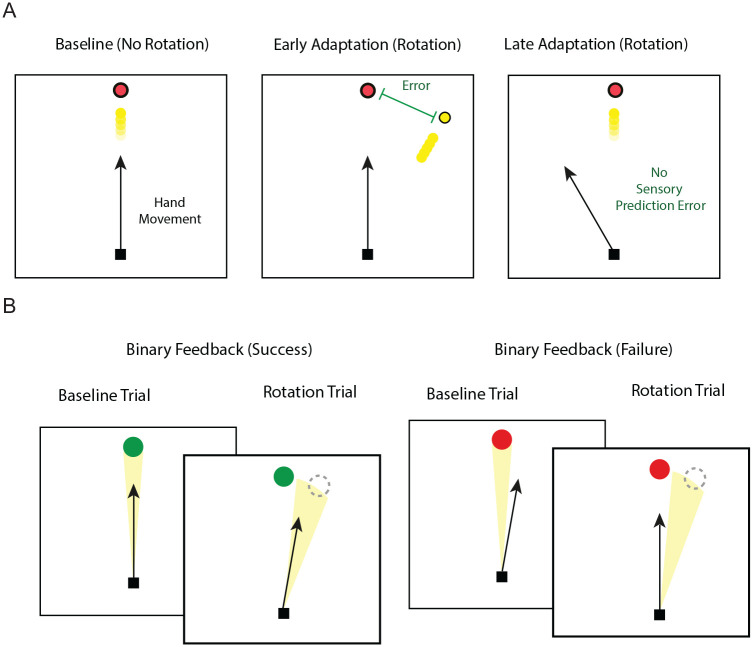Figure 2.
Behavioral studies over the past several years have used several forms of motor adaptation tasks (e.g., rotations, prisms, force-field, split-belt walking) to elucidate the learning processes responsible for calibrating the mapping between desired outcomes and motor commands. This process is critical for our ability to adjust our daily movements to environment demands, such as walking over different surfaces (i.e., concrete, sand, ice). In adaptation tasks, a perturbation is suddenly introduced, altering the relationship between a movement and its resulting sensory feedback in the task workspace. (A) This figure depicts a commonly used visuomotor reaching adaptation task. In this setup, participants are asked to make “shooting” reaches toward a visual target by moving an on-screen cursor (yellow dot). The cursor represents the position of their hand (i.e., participants vision of the arm is blocked), therefore perturbations can be applied to the cursor (i.e., visuomotor transformations). The “shooting” action does not allow participants to correct movements within a trial, but rather only for learning via through endpoint feedback error to adjust movements on the next trial (i.e., feed-forward sensory prediction errors). Participants are capable of performing accurate reaches to targets within the workspace when there is no visuomotor manipulation (baseline). When a rotation is applied to the cursor unknowingly to the participants, they initially execute and observe large errors (early adaptation). The goal of the task for the participant then becomes to minimize the movement error between the cursor and target (i.e., minimize sensory prediction errors). This can be accomplished over multiple reaches. If the cursor perturbation is then removed, participants execute errors in the opposite direction, depicting the retention of the previously acquired sensory-motor map. (B) By providing only binary feedback about task performance (i.e., success or failure), participants can also learn a cursor rotation using reinforcement learning. In this example, if the participants land in the correct zone (highlighted in yellow) a “success” visual feedback is provided (green). However, if the participant does not land in this zone, they are given a “failure” feedback (red). Unlike learning from sensory prediction errors, learning via reinforcement does not lead to sensorimotor recalibration. Explicit processes (i.e., aiming strategies; not shown) also influences visuomotor learning, in particular when large rotations are introduced.

